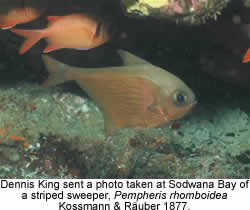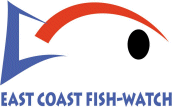

Conducted by

Sponsored by
East Coast
Fish-Watch Project
MID-YEAR REPORT 2006
Find on this report:
- SANCOR – Communicator of the Year Award for 2005
- WELCOME ABOARD PHANOR AND JESSICA
- NUGGETS OF NEW INFORMATION
- FISHWATCH FLIPFILE
- A NEW SPECIES OF SOLE DESCRIBED FROM ALIWAL SHOAL AND SODWANA BAY!
SANCOR – Communicator of the Year Award for 2005
The Marine and Coastal Communicators of the Year Awards are hosted under the auspices of SANCOR (South African Network for Coastal and Oceanic Research) and are awarded to individuals for outstanding contributions towards making our knowledge of the marine and coastal environment accessible to the public. A broad definition of communication was used (public talks, popular articles, books, videos, hands-on education, and education projects) to assess the nominations in the different categories. The Awards for 2005 were hosted by SANCOR at the Two Oceans Aquarium in Cape Town in January this year. The preamble to the scientific category award reads:
“In the scientific category, the marine research community congratulated Dr Phil Heemstra and his wife Elaine. Dr Phil Heemstra has spent a life-long career dedicated to sharing his knowledge of fishes with fellow researchers and the wider public. His development of the innovative East Coast Fish Watch Project has inspired many people to learn more about fishes and how to identify them. His correspondence and interaction with divers and underwater photographers has done much to elucidate the fish diversity of southern Africa and the western Indian Ocean.
One of the major achievements in the past five years for Dr and Ms Heemstra has been the publication of their book – Coastal Fishes of Southern Africa. This fantastic book not only helps with the identification of fish species but also provided invaluable information on fish biology and ecology. It is an information source that clearly bridges the gap between the scientific knowledge of fishes and the pragmatic and aesthetic appreciation of our wonderful fish diversity. Following on from this Dr and Ms Heemstra are also currently working on a second book on the Coastal fishes of the Western Indian Ocean – this book involves some 50+ collaborators and will be a worthy successor to the previously internationally acclaimed Smiths’ Sea Fishes published in 1986.
Over and above this, the Heemstras have been instrumental in developing a coastal fish check-list for the Mauritian island of Rodrigues along with teaching activities which have resulted in improved knowledge and management of the Rodrigues fish fauna. Phil and Elaine have also been involved in the production of the United Nations FAO marine fish guides which are used throughout the world and enable fish biologists to identify and effectively manage their fish resources. At the same time he has been involved with teaching students at Rhodes University - Department of Ichthyology and Fisheries Sciences. These are just a few of the many achievements of Dr and Ms Heemstra which have resulted in a career that has brought the world of coastal fishes to all who use and share the sea and its resources – based on this they are worthy recipients of the Communicator of the Year Award – Scientific Category.”
In accepting this award, Phil Heemstra emphasised the importance of the Sappi-funded East Coast Fish-Watch Project to their research and also for their interactions with divers and the general public.
WELCOME ABOARD PHANOR AND JESSICA
The East Coast Fish-Watch Project has accepted our first Education Officer, Phanor Montoya-Maya. Phanor and his wife Jessica Escobar recently arrived from Colombia and are registered for their M.Sc. degrees in the Department of Ichthyology and Fisheries Science at Rhodes University. As a qualified scuba instructor with knowledge of marine biology, and experience in teaching marine biology to divers, Phanor is keen to get involved with the education components of the Fish-Watch Project. With his enthusiasm for the subject and his plans for teaching divers how they can help us monitor our fish communities, Phanor has great potential to help us develop the Fish-Watch Project vision of “reciprocal illumination” between divers and scientists. Phanor can be contacted at p.monto-maya@ru.ac.za or fishwatch@ru.ac.za.
The ECFW Project is considering new educational activities. However, to plan, organize and develop these new activities, we need to estimate the portion of the diving community willing to take part in them. We have prepared a short questionnaire that is to be answered by scuba divers from the east coast or likely to dive there. Your participation as a diver is very important for this survey. The questionnaire can be filled online or downloaded from the Fish-Watch website: http://fishwatch.tripod.com
NUGGETS OF NEW INFORMATION
NEW DISTRIBUTION RECORDS FOR SOUTH AFRICA
 The twospot damsel, Chrysiptera biocellata (Quoy & Gaimard, 1825) was photographed at Kosi Bay by Dennis King and John du Plessis. This Kosi Bay record is a range extension, the species was formerly known from the Indo-West Pacific, Kenya south to Mozambique. The twospot damsel is found in rubble and rock outcrops of lagoons and inshore reefs in 0-5 m.
The twospot damsel, Chrysiptera biocellata (Quoy & Gaimard, 1825) was photographed at Kosi Bay by Dennis King and John du Plessis. This Kosi Bay record is a range extension, the species was formerly known from the Indo-West Pacific, Kenya south to Mozambique. The twospot damsel is found in rubble and rock outcrops of lagoons and inshore reefs in 0-5 m.
Dennis King also sent in a photo taken at Sodwana Bay of a striped sweeper, Pempheris rhomboidea Kossmann & Räuber 1877. This species was not known from southern Africa and the distribution is now South Africa to the Red Sea and across to Western Australia. This sweeper has the dorsal fin with dark tips only on the anterior rays; and it is the only sweeper we have with dark stripes following the scale rows.
The maiden glider-goby, Valenciennea puellaris (Tomiyama 1956) is another species not previously known from southern Africa but which was recently photographed at Sodwana Bay by Dennis Polack.
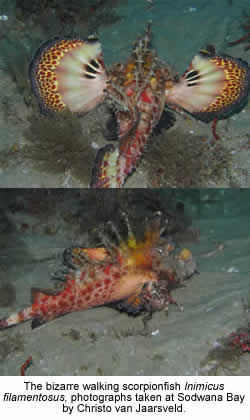 In his regular Divestyle column, Fishwatch member, Christo van Jaarsveld, of Adventure Mania at Sodwana Bay produced a new record for South Africa. His photograph taken at Sodwana Bay of the bizarre walking scorpionfish Inimicus filamentosus was another first. This species is rare in fish collections, and we have only one specimen from Kenya at SAIAB. Dr Stuart Poss, a world expert on scorpionfishes, was visiting SAIAB at the time and he was unaware that the species was in South Africa until he saw Christo’s photograph. In the literature and in fish collections the most southerly localities for this species are Madagascar, Mauritius and Reunion. The photographs were taken at Grant’s Beach, Sodwana, in 48-54 m on a sandy bottom near a reef covered with sponges and feather stars.
In his regular Divestyle column, Fishwatch member, Christo van Jaarsveld, of Adventure Mania at Sodwana Bay produced a new record for South Africa. His photograph taken at Sodwana Bay of the bizarre walking scorpionfish Inimicus filamentosus was another first. This species is rare in fish collections, and we have only one specimen from Kenya at SAIAB. Dr Stuart Poss, a world expert on scorpionfishes, was visiting SAIAB at the time and he was unaware that the species was in South Africa until he saw Christo’s photograph. In the literature and in fish collections the most southerly localities for this species are Madagascar, Mauritius and Reunion. The photographs were taken at Grant’s Beach, Sodwana, in 48-54 m on a sandy bottom near a reef covered with sponges and feather stars.
THAT’S A MORAAAAAY!
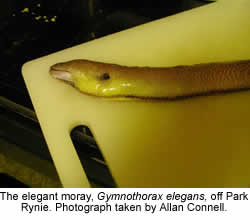 Allan Connell who first reported the elegant moray, Gymnothorax elegans off Park Rynie last year collected 3 specimens for the SAIAB collection and the international DNA bar-coding initiative. He has also recognised a couple of other elegant morays while diving, and thinks that they must be fairly common at 40 m off Park Rynie. This species was originally described from Mauritius and before Allan found it at Park Rynie the only known Southern African locality was Inhaca Island, Mozambique.
Allan Connell who first reported the elegant moray, Gymnothorax elegans off Park Rynie last year collected 3 specimens for the SAIAB collection and the international DNA bar-coding initiative. He has also recognised a couple of other elegant morays while diving, and thinks that they must be fairly common at 40 m off Park Rynie. This species was originally described from Mauritius and before Allan found it at Park Rynie the only known Southern African locality was Inhaca Island, Mozambique.
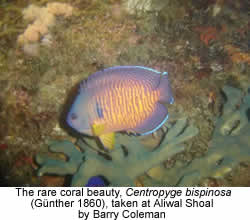 Barry and Celia Coleman of Meridian Dive Centre, Umkomaas, sent us photos of the rare coral beauty, Centropyge bispinosa (Günther 1860) taken at Aliwal Shoal. Its scientific name comes from having only 2 spines on the preopercle. (The common dusky cherub, Centropyge multispinis has many spines on its preopercle.) The yellow pectoral and pelvic fins, usually orange body (body colour is very variable) and lack of a large oval dark spot just behind the upper gill opening distinguish the coral beauty from the similar dusky cherub. Most coral beauties have a bluish blotch behind the slightly oblique body bars, but this is lower than the dark oval spot on the dusky cherub, and the bars are not obscured by the blotch. We have only one coral beauty in our collection (from Sodwana) and 2 photographs from South Africa (the Sodwana specimen, and one underwater photo taken at Sodwana by Dennis King). The Coleman’s photographs are the first to document the range extension to the Aliwal Shoal / Rocky Bay area.
Barry and Celia Coleman of Meridian Dive Centre, Umkomaas, sent us photos of the rare coral beauty, Centropyge bispinosa (Günther 1860) taken at Aliwal Shoal. Its scientific name comes from having only 2 spines on the preopercle. (The common dusky cherub, Centropyge multispinis has many spines on its preopercle.) The yellow pectoral and pelvic fins, usually orange body (body colour is very variable) and lack of a large oval dark spot just behind the upper gill opening distinguish the coral beauty from the similar dusky cherub. Most coral beauties have a bluish blotch behind the slightly oblique body bars, but this is lower than the dark oval spot on the dusky cherub, and the bars are not obscured by the blotch. We have only one coral beauty in our collection (from Sodwana) and 2 photographs from South Africa (the Sodwana specimen, and one underwater photo taken at Sodwana by Dennis King). The Coleman’s photographs are the first to document the range extension to the Aliwal Shoal / Rocky Bay area.
Another range extension was recorded when Japie Kamminga sent photos of a juvenile halfmoon butterflyfish, Chaetodon lunula. He saw several specimens in Stilbaai harbour and the Goukou River. In the Coastal fishes of Southern Africa the southerly distribution of the halfmoon butterflyfish is recorded to Port Alfred. Shortly afterwards Japie found another range extension and first for Stilbaai: the whitespotted butterflyfish Chaetodon kleinii, previously known to Algoa Bay.
INTERESTING SIGHTINGS
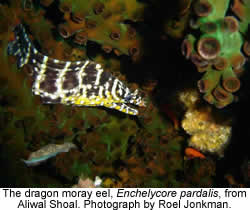 A few years ago we collected a juvenile dragon moray eel, Enchelycore pardalis, in a tidepool near Scottburgh but we had never seen or heard of an adult specimen from Aliwal Shoal until Roel Jonkman sent us an excellent photograph of one. This species is noted for its long tubular nostrils which resemble the horns of a dragon and its many-hued colouration.
A few years ago we collected a juvenile dragon moray eel, Enchelycore pardalis, in a tidepool near Scottburgh but we had never seen or heard of an adult specimen from Aliwal Shoal until Roel Jonkman sent us an excellent photograph of one. This species is noted for its long tubular nostrils which resemble the horns of a dragon and its many-hued colouration.
FISHWATCH FLIPFILE
We hope that Fishwatch members enjoy the flipfile that we sent out with the butterflyfish colour plate and text including new (2005) discoveries. The latest flipfile colour plate and text of the worm-fishes, dart-gobies and fire-gobies includes species known from southern Africa as well as a couple of species from northern Mozambique which might be found here.
A NEW SPECIES OF SOLE DESCRIBED FROM ALIWAL SHOAL AND SODWANA BAY!
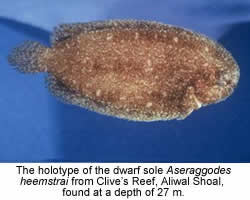 A new species of sole has just been described by Jack Randall (Hawaii) and Ofer Gon (SAIAB, Grahamstown) using 5 specimens from Aliwal Shoal, 2 specimens from Sodwana Bay and one from Protea Bank. This dwarf sole has been named Aseraggodes heemstrai after Phil Heemstra who collected most of the specimens over the last decade as part of the Fishwatch programme using funding from SAPPI. The species has been found on sand near rocky reefs to depths of 39 m and at present is only known from South Africa.
A new species of sole has just been described by Jack Randall (Hawaii) and Ofer Gon (SAIAB, Grahamstown) using 5 specimens from Aliwal Shoal, 2 specimens from Sodwana Bay and one from Protea Bank. This dwarf sole has been named Aseraggodes heemstrai after Phil Heemstra who collected most of the specimens over the last decade as part of the Fishwatch programme using funding from SAPPI. The species has been found on sand near rocky reefs to depths of 39 m and at present is only known from South Africa.
Please keep your photos, queries, comments, and suggestions coming in. We are always happy to hear from you.
Best regards, Phil, Elaine and Phanor.
